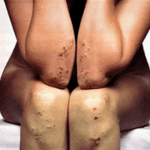
Currently, the only treatment for celiac disease is a strict, lifelong gluten-free diet. Eating gluten, even in small amounts, can damage the intestine in those with celiac disease.
A gluten-free diet means avoiding all foods that contain wheat, rye, and barley in all forms. It is important to read all labels carefully for these ingredients, as sometimes, they are listed under less common names.
For example, wheat may be referred to as the following on ingredient labels:
Despite these restrictions, people with celiac disease can eat a well-balanced diet with a variety of foods, including gluten-free bread and pasta.
Many gluten-free alternatives are now made with potato, rice, soy, or bean flour. In addition, plain meat, fish, fruits and vegetables are naturally gluten-free, so people with celiac disease can continue to eat these foods after diagnosis.
Following a gluten-free diet may seem daunting at first, but, with a little creativity, anyone can make delicious gluten-free meals. Visit the Gluten-Free Recipes section for delicious meal ideas.
| Download: The Gluten-Free Diet Overview |
| Download: The Getting Started Guide |
Celiac disease damages the villi, which are finger-like projections in the small intestine. Villi are responsible for absorbing nutrients from food. Because of this, it is highly likely that people with celiac disease will be deficient in essential vitamins and nutrients when diagnosed. Laboratory tests should be done within three to six months following a diagnosis and annually for the rest of your life.
Regular monitoring with blood tests can help to answer the following questions:
Laboratory tests to include in celiac disease management include:
Adults with celiac disease should have a bone mineral density scan within the first year after diagnosis.
The specific tests you receive will vary depending on your situation and your doctor’s advice. Please use these tests as a guide to your lifelong management of celiac disease.
While blood tests are extremely helpful, visiting a registered dietitian knowledgeable of celiac disease and the gluten-free diet is considered the “gold standard” for understanding how to know if you are accidentally being exposed to gluten (even if symptoms are not present).
The American Gastroenterological Association and the American College of Gastroenterology recommend regular healthcare follow-up with a physician and dietitian for those with celiac disease. This care is seen as critical in providing patients with accurate information about the gluten-free diet, which is currently the only treatment for celiac disease, and improving adherence to it. Managing Celiac Disease Involves:
Pediatric celiac disease management should also focus on monitoring the child’s growth, discussing the need for a 504 plan at the child’s school, and age-specific support groups and/or summer camps.
Learn more about celiac disease management and monitoring.
While the gluten-free diet has proven to be an effective treatment for many with celiac disease, there are many challenges in adopting and maintaining a gluten-free diet that can impact a person’s quality of life and long-term health outcomes. Additionally, 30 percent of those with celiac disease are not healing on the gluten-free diet alone. Patients, doctors and researchers agree that there is a great need for alternative treatments that could replace or supplement the gluten-free diet.
Potential treatments for celiac disease are being designed to interrupt different steps in the disease process. Learn more about potential treatments:
 Dermatitis herpetiformis (DH) is the severe skin rash associated with celiac disease. Its symptoms are extremely itchy and blistering skin. Sometimes referred to as gluten rash or celiac rash, DH is a chronic condition that is considered to be the skin form of celiac disease.
Dermatitis herpetiformis (DH) is the severe skin rash associated with celiac disease. Its symptoms are extremely itchy and blistering skin. Sometimes referred to as gluten rash or celiac rash, DH is a chronic condition that is considered to be the skin form of celiac disease.
Dermatitis herpetiformis treatment consists of a lifelong gluten-free diet, just like celiac disease. The skin’s response to the gluten-free diet is much slower compared to the healing of the intestines with celiac disease. It may take about six months to achieve some improvement in the skin condition and up to two years or more to get total control through the gluten-free diet alone.
Rash symptoms can be controlled with medications, such as Dapsone. In general, itching and new lesions will begin to subside within 48-72 hours of starting Dapsone. However, this medication does not treat the intestinal condition, meaning that people with DH should also maintain a strict lifelong gluten-free diet.
Learn more about Dermatitis Herpetiformis.
Opt-in to stay up-to-date on the latest news.
Yes, I want to advance research No, I'd prefer not to